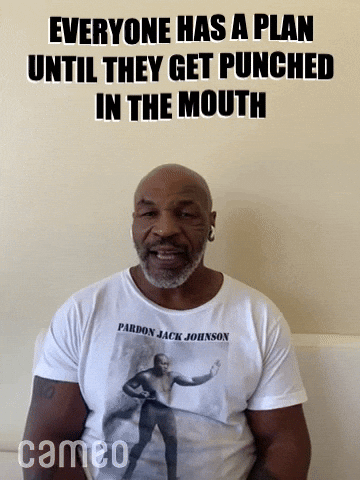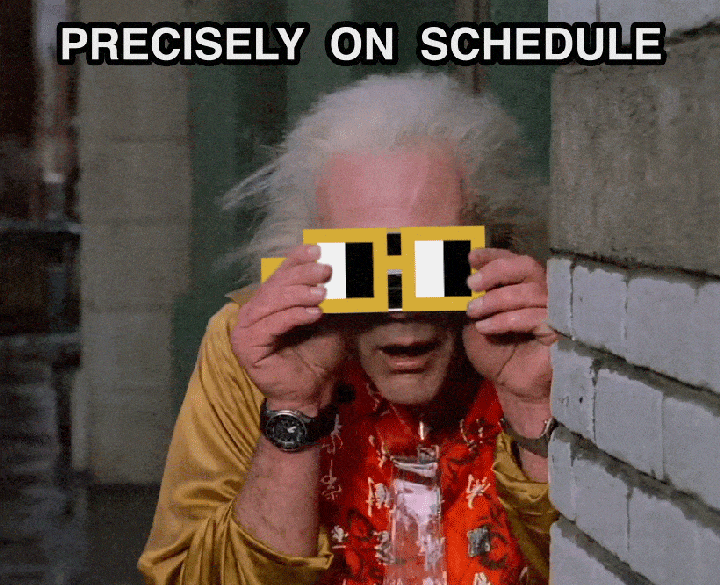- The High Performance Playbook
- Posts
- Stop Reacting, Start Anticipating: The Future-Oriented Edge
Stop Reacting, Start Anticipating: The Future-Oriented Edge
The High Performance Playbook
Welcome to Week 36 of the High Performance Playbook.
You’re now reading with over 16,000 other high performers! Huge thank you for reading and continuing to share The High Performance Playbook with friends, family, and co-workers. Your support means the world.
If you’re new and just tuning in to the HPP, we cover the strategies and frameworks that separate the 1% from the .01%. We dive deep into: health & fitness + longevity, personal finance & investing, business growth hacks, and how to optimize all areas of your life.
If any of those topics sound interesting, the High Performance Playbook is for you.

If you enjoy the content and get some value from it, please share this link with a few friends and help me spread the word! There’s no better compliment than a referral.
Ready? Start your engines… Let’s GO:

Before we dive into today’s newsletter….
As I’ve said before, I’m not an affiliate marketer. I’m not an “influencer.” And I don’t often promote products or services to my network… unless I find something that I 1000% believe in. Well… this is one of those things.
Most of the founders I talk to have their businesses dialed in.
Revenue’s up.
Teams are growing.
Deals are moving.
But behind the scenes? Their health is falling apart.
Truth is, we treat our companies like performance machines… and our bodies like an afterthought. Running on caffeine, stress, and 4-5 hours of sleep like it’s normal.
That’s why I wanted to share something I genuinely believe in:
My friend Anthony runs a company called Daily Body Coach, and it’s built specifically for high-performers like us.
He works with CEOs, execs, and entrepreneurs to design custom fitness and nutrition systems that actually fit your lifestyle.
This isn’t a cookie-cutter workout or nutrition plan. It’s:
Executive-level accountability
Personalized programs that adapt to your calendar, travel, and workload
A results-driven system that doesn’t require you to sacrifice your business to fix your body
If you’ve ever thought, “I just need someone to build the plan and hold me to it…” this is that.
It’s often difficult to get a spot with Anthony because he only takes a select number of clients each quarter, but right now he has availability, so I wanted to share with all of you.
Spots are limited and they only take on a handful of clients at a time. But if you’re serious about matching your physical performance to your professional one, this is the program I’d recommend… I’ve been through it myself and it’s LEGIT. No fluff, no guesswork.
Because your business isn’t the only thing that should be scaling. Your energy, focus, and longevity should be too.
Mindset & Psychology

The Anticipation Advantage: Harness Future-Oriented Thinking
High performers operate from a different mental gear. They don’t just react to what’s in front of them; they anticipate what’s coming next.
Anticipation is the bridge between awareness and strategy. It’s not daydreaming or idle prediction.
It’s a disciplined way of structuring your mind to recognize signals, prepare responses, and position yourself to seize opportunities before they appear obvious.
In practical terms, anticipation can be built into your daily rhythm. Before starting a meeting, presentation, or project, spend five minutes walking through potential scenarios.
What’s the best-case outcome?
The most likely?
The worst?
How will you respond to each?
Write down your first move for every case. The goal isn’t to predict perfectly; it’s to shorten your reaction time when real variables appear.
The brain doesn’t easily distinguish between imagined and real experiences, which means rehearsing future scenarios trains your nervous system for composure and adaptability.
Over time, this habit compounds. You stop being surprised by predictable problems. You begin to notice early signals others miss: tone shifts in conversations, emerging trends in data, subtle breakdowns in process.
Because you’ve mentally run the play before, you respond with calm precision instead of scrambling under pressure.
The difference between reactive and anticipatory thinkers is design, not intelligence. Reactors let circumstances dictate tempo. Anticipators set it.
They move with intentional speed, adapting dynamically without losing composure.
To harness anticipation, keep your focus narrow and actionable. Don’t drift into fantasy scenarios or endless what-ifs.
Discipline your mind around controllable variables: what inputs you can monitor, what decisions are reversible, what actions move the needle. The goal is not to predict the future but to prepare for it with clarity.
When you train anticipation, you reduce hesitation, strengthen confidence, and increase mental agility. You stop wasting energy on surprise and start investing it in execution.
In a world obsessed with reacting faster, the real edge belongs to those who’ve already thought ahead.
Check out our new section below where we curate the biggest story of the week you may have missed in each of our core pillar categories.
😴 Biggest Story of the Week (Mindset & Psychology)
Visualization Boosts Decision Speed Under Pressure
A recent article from SciSimple highlights new research showing that structured visualization, mentally simulating possible outcomes before acting, enhances executive decision-making under stress.
The findings, based on cognitive science studies from the University of Melbourne and others, suggest that leaders who visualize potential scenarios make faster, more accurate choices and experience less cognitive fatigue.
Why it matters: Visualization isn’t daydreaming, it’s deliberate rehearsal. By practicing structured mental simulations, you train your brain to anticipate outcomes, respond with clarity, and stay composed when pressure hits.

Health & Fitness + Longevity

Chrono-Conditioning: Aligning Workouts With Your Biological Clock
Timing isn’t just a matter of convenience; it’s biology. Recent research on circadian rhythms shows that when you exercise can be just as important as how you exercise.
Chrono-conditioning is the science of syncing your training with your internal body clock to optimize energy use, hormonal balance, and recovery.
The goal is to stop fighting your natural rhythm and start working with it.
Recent studies like this one have found that physical performance, muscle adaptation, and fat metabolism vary throughout the day.
Morning workouts often improve fat oxidation and consistency because they align with cortisol’s natural peak, a hormone that helps mobilize energy.
Afternoon or early evening sessions, on the other hand, take advantage of higher body temperature and neuromuscular efficiency, which can boost strength, power output, and endurance.
Practically speaking, the best time to train depends on your personal chronotype, your natural inclination toward being a “morning” or “evening” person. Track your energy and focus levels over a week.
Note when you feel most alert, motivated, and physically strong. That’s your optimal training window. High-intensity or resistance training fits best here, when your body and brain are naturally primed for effort.
During lower-energy periods, prioritize recovery-based movement, such as mobility drills, walking, yoga, or stretching.
Chrono-conditioning isn’t about rigid scheduling. It’s about strategic alignment. When you train in line with your internal rhythms, you improve both physiological and cognitive outcomes.
Recovery times shorten, hormonal balance stabilizes, and you experience fewer energy crashes throughout the day.
Mental clarity also improves, as the timing of exercise affects neurotransmitter cycles related to focus and mood.
In short: your workouts should fit your biology, not your calendar. Aligning physical effort with your body’s natural peaks creates a feedback loop; better workouts, faster recovery, and sharper performance across every domain of life.
Chrono-conditioning turns exercise from a daily task into an energy amplifier.
🏃♂️ Biggest Story of The Week (Health & Fitness)
Resetting Your Inner Clock: Why Timing Your Habits Matters
As the clocks shift back to standard time, sleep scientists say our bodies breathe a quiet sigh of relief, but that doesn’t mean the transition is easy.
Our internal clocks, finely tuned to light and darkness, now face longer nights and shorter days. And how we respond, when we eat, sleep, and move, can have major effects on our health.
Why it matters: Aligning your schedule with your biological clock isn’t about perfection. It’s about rhythm. Studies show that consistent sleep, early eating windows, and exercise timed to your natural energy peaks reduce the risk of chronic diseases like diabetes, heart disease, and obesity. Even a 10-hour eating window and a regular bedtime can dramatically improve glucose control and energy stability.

Personal Finance Tip of the Week

The Optionality Portfolio: Flexibility Outperforms Prediction
Traditional investing often emphasizes precision: forecasting returns, timing the market, or picking “winners” based on past performance. But high performers take a different approach.
They don’t try to predict the future perfectly.
They design for flexibility. This is the principle of optionality: creating a portfolio that allows you to pivot, scale, or redeploy capital quickly in response to changing conditions. Optionality turns uncertainty from a risk into an advantage.
At its core, an optionality portfolio isn’t about chasing the highest returns on paper; it’s about building leverage across scenarios.
You want structures that reward action rather than foresight alone. When the market shifts, opportunities arise, or your personal strategy evolves, optionality gives you the freedom to act decisively rather than being stuck in rigid positions.
So how do you build this flexibility?
Start with diversification across asset classes, liquidity profiles, and geographies. Core holdings like stable equities (I personally love the QQQ ETF), Bitcoin, or real estate, anchor your portfolio and provide resilience.
Around them, layer assets with asymmetric upside: early-stage ventures, royalties, alt-coins, private equity, or other nontraditional instruments that can generate outsized gains with limited initial exposure.
These positions may not dominate your returns in a given year, but they give you plenty of optionality when favorable conditions appear.
Liquidity management is another crucial lever. Maintaining ready access to deploy capital enables you to take advantage of distressed opportunities, strategic acquisitions, or market inefficiencies.
Optionality is about defense just as much as growth. By keeping parts of your portfolio uncommitted or highly liquid, you mitigate downside risk and reduce the pressure to act from panic rather than strategy.
Finally, optionality is also a mindset. It requires constantly scanning the horizon for emerging trends, being willing to restructure allocations, and recognizing when to scale up or pull back.
High performers treat their capital like a Swiss army knife: versatile, adaptable, and ready for the unexpected.
In practice, optionality compounds quietly but powerfully. You may not hit every market top or bottom, but you position yourself to capture opportunities and limit losses regardless of market direction.
In uncertain environments, flexibility almost always outperforms prediction.
By designing your portfolio around optionality rather than perfect foresight, you convert uncertainty from a liability into a lever for growth, resilience, and long-term strategic advantage.
💸 Biggest Story of the Week (Personal Finance)
Rate Cuts Not a Given
Federal Reserve Chairman Jerome Powell dampened market expectations for an automatic interest rate cut in December, stating it is “not a foregone conclusion - far from it.”
His comments came after markets had largely priced in a 25-basis-point reduction. Powell also acknowledged internal division within the Fed, with two policy committee members dissenting over whether to cut or pause rates.
Why it matters: Investors and businesses had been anticipating lower borrowing costs, but Powell’s caution signals that the Fed is prioritizing economic data over market assumptions. When things don’t go the way you expect them to, optionality becomes your saving grace.

Business Playbook

Friction Mapping: Where Invisible Barriers Are Costing You Growth
High-performing organizations don’t just focus on revenue, strategy, or market share. They pay attention to invisible drag.
This is the energy lost in stalled decisions, unclear ownership, or inefficient workflows. High performers call this “friction,” and they map it deliberately. Friction mapping identifies points across processes, teams, and customer interactions where momentum is lost.
Each friction point is a hidden cost, like time, attention, or resources consumed, that isn't reflected on a balance sheet.
The first step is observation. Track workflows and interactions: where do approvals pile up? Which handoffs repeatedly fail? Where do employees spend time duplicating work or clarifying responsibilities?
Document these pain points and quantify their impact. Even small inefficiencies, when multiplied across dozens of employees or processes, can translate into significant lost revenue or delayed product launches.
Once you’ve mapped the friction, you can address it systematically. Simplify decision-making by clarifying ownership and defining escalation paths.
Automate repetitive actions that don’t require judgment. Streamline processes by removing unnecessary steps or approvals.
Encourage cross-functional teams to surface hidden bottlenecks. They often know where delays occur before management does.
Friction mapping is not a one-time exercise; it’s iterative. Set up feedback loops so improvements can be tracked and new friction points identified.
Over time, these small optimizations compound. Decisions move faster, teams collaborate more smoothly, and employees spend their energy on high-leverage work instead of firefighting inefficiencies.
Morale improves as frustration from repeated bottlenecks diminishes, and customer experiences benefit from smoother interactions.
The ultimate payoff of friction mapping is momentum. Companies that systematically remove invisible barriers operate with the speed, clarity, and flexibility of high-performing teams.
They free up resources for innovation, growth, and scaling rather than constant troubleshooting.
By making friction visible and addressable, leaders can turn what was once wasted energy into a strategic advantage, creating a culture that prizes efficiency, accountability, and continuous improvement.
Friction may be invisible, but its cost is real.
Map it, measure it, and methodically remove it, and your organization will not just perform better; it will accelerate toward its goals with less wasted effort and more predictable outcomes.
👨🏫 Biggest Story of the Week (Business)
Amazon Cuts 14,000 Corporate Jobs to Streamline Culture
Amazon announced layoffs of 14,000 corporate employees this week, the largest reduction in the company’s history outside of its 2022–2023 cuts.
CEO Andy Jassy clarified that the decision was driven not by AI or financial pressures but by a desire to reshape internal culture and improve agility.
Why it matters: Jassy emphasized the need for Amazon to operate like “the world’s largest startup,” removing unnecessary layers to empower employees who execute the work. The approach underscores a shift in leadership thinking from scaling headcount to scaling effectiveness and empowering decision-makers closer to the front lines. For other tech and corporate leaders, this serves as a reminder that culture, clarity, and workflow design can be as critical to growth and performance as revenue or technology.

DOPAMINE HIT

Thanks for reading!
If you enjoyed this week’s newsletter, please share it with some friends! And thank you for reading!
🗓️ STAY TUNED:
Next week, we’ll look at how the narrative you cultivate can be an engine for your business’s growth.
… Stay tuned. You won’t want to miss it!
Here’s to your success,

Austin L. Wright

Join my inner circle - Follow me on X for daily business breakdowns, lifestyle hacks, and a behind-the-scenes look at what my team and I are building.
Follow me on IG to see how I’m living the blueprint. I practice what I preach.
P.S.
We’re always looking to improve and create better newsletters for you in the future. If you have any feedback or suggestions for future editions, I’d love to hear from you! Just reply directly to this email and give me some ideas for how you think we could make it better!
If you’re reading this online, make sure you subscribe using the button below:
Disclaimer: The ideas shared in this newsletter are those of the author, and this is in no way intended to be medical, legal, or financial advice. Always do your own research and consult with licensed professionals.
Reply